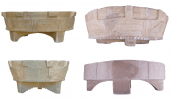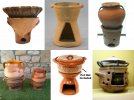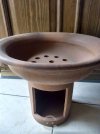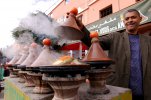Request: Anafres: clay portable stoves and braziers
Request Type: Unique Addition (specific to a build, region, or culture)
Describe the use of this block in said build, region, or culture. How is it unique? To the best of your knowledge how could it be used in a different context?


Types of evidence to support your request: Historical
Historical Evidence
Request Type: Unique Addition (specific to a build, region, or culture)
Describe the use of this block in said build, region, or culture. How is it unique? To the best of your knowledge how could it be used in a different context?
I've made a post talking about portable stoves in ancient times and how them could be used in Dorne and on multi tentants on the big cities of the south as a way of showing a change in culture, differences in wealth and so on. Some showed interest in the idea and the work-arounds I suggested, while others thought it would be worth of a full on new block. So that's why I'm making this request. Most of it would be repetitive, so if you have already read the original post, you know the drill by now.
These devices would be a nice way of making Dorne feel more unique, as with them not only would the architectural style change, but also the floorplan of houses, now that there's no chimney. Styles change more than the pallete or some decorative details, all aspects of a build and how it interacts with the surroundings are affected as well. It also could be used in houses (mainly insulae and multi tenantes) of Oldtown and Vinetown. Although for this areas the regular braziers might be a better fit.
Regarding the minecraft block itself, I've thought about several posibilities. We could make something similar to the Dorne mud furnace but slimer (not as slim as a wall thought), and maybe with some shape. Keeping the full block height would allow pans and pots to be placed over it, making their use more obvious to those non familiar with it. Another option would be to make it more like a dish, with lower height but wider. This would not allow objects to be placed over it.


I think this shape is quite good, probably my favourite: a big cooking area and a slim tower body with a hole for the embers. If this is chosen it may be good to make it orientable, like furnaces right now. Also it might be good to make a lit and unlit version. If made full block height (but maybe not as wide) pans and even plates with food could be placed over it (and pots if they're ever implemented). For practicality we can call it the "mushroom shape".
These devices would be a nice way of making Dorne feel more unique, as with them not only would the architectural style change, but also the floorplan of houses, now that there's no chimney. Styles change more than the pallete or some decorative details, all aspects of a build and how it interacts with the surroundings are affected as well. It also could be used in houses (mainly insulae and multi tenantes) of Oldtown and Vinetown. Although for this areas the regular braziers might be a better fit.
Regarding the minecraft block itself, I've thought about several posibilities. We could make something similar to the Dorne mud furnace but slimer (not as slim as a wall thought), and maybe with some shape. Keeping the full block height would allow pans and pots to be placed over it, making their use more obvious to those non familiar with it. Another option would be to make it more like a dish, with lower height but wider. This would not allow objects to be placed over it.


I think this shape is quite good, probably my favourite: a big cooking area and a slim tower body with a hole for the embers. If this is chosen it may be good to make it orientable, like furnaces right now. Also it might be good to make a lit and unlit version. If made full block height (but maybe not as wide) pans and even plates with food could be placed over it (and pots if they're ever implemented). For practicality we can call it the "mushroom shape".

This would be closer to the flat, wide non full block shape I was talking about. The "dish shape".

Many anafres come with a matching pot. That could be another option: making a combined pot + anafre block. I'm personally more inclined to make a separate pot block and using it over the other options (and everywhere else).

There's also the tajine, a Maghreb pot used to cook many of the dishes of the region. The pot itself is made of a conical lid and a plate like bottom. Street vendors (another potential usage of this block addition in general) put tajines in anafres to cook outside.

There's also the tajine, a Maghreb pot used to cook many of the dishes of the region. The pot itself is made of a conical lid and a plate like bottom. Street vendors (another potential usage of this block addition in general) put tajines in anafres to cook outside.
Types of evidence to support your request: Historical
Historical Evidence
Not all houses have a fireplace. In al-Ándalus smaller or more modest houses didn't. This isn't just due to a milder climate, since both during the night and in the winter it can get quite cold in many areas of Spain. It's more of a cultural practise. When the christian kingdoms of the north conquered the muslim cities, they added fireplaces and chimneys to the houses they occupied. So where did people cook, and how did they kept themselves warm during the cold hours and days? Well, they had portable stoves.
Depending on their use this devices received two different names: anafre or brasero. Anafres were made out of clay or metal, and were used to cook, heat or maintaing food warm. Due to this two last functions houses with a fireplace sometimes also had this device to transport the prepared dishes to the "dining hall". They were made of two parts: the area where the embers were kept and the surface on top, where pots and pans were placed.
Braziers and anafres (or similar looking devices) weren't only used in al-Ándalus, of course! Ancient egyptians, greeks, romans, japanese, mesoamericans... all had similar objects that worked for heating and cooking. In fact braziers were in many cases the cause of fires in the insulae, the roman apartment buildings, since poor people used them to kept themselves warm and cook.
Depending on their use this devices received two different names: anafre or brasero. Anafres were made out of clay or metal, and were used to cook, heat or maintaing food warm. Due to this two last functions houses with a fireplace sometimes also had this device to transport the prepared dishes to the "dining hall". They were made of two parts: the area where the embers were kept and the surface on top, where pots and pans were placed.
Braziers and anafres (or similar looking devices) weren't only used in al-Ándalus, of course! Ancient egyptians, greeks, romans, japanese, mesoamericans... all had similar objects that worked for heating and cooking. In fact braziers were in many cases the cause of fires in the insulae, the roman apartment buildings, since poor people used them to kept themselves warm and cook.










